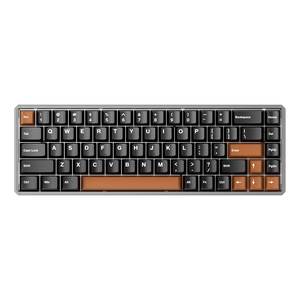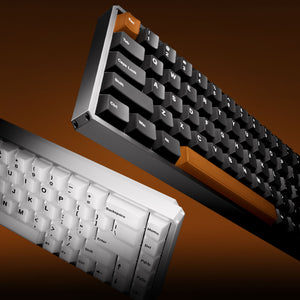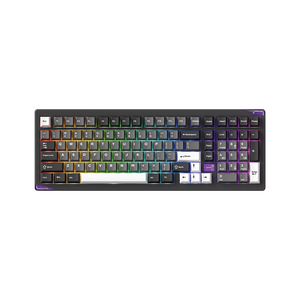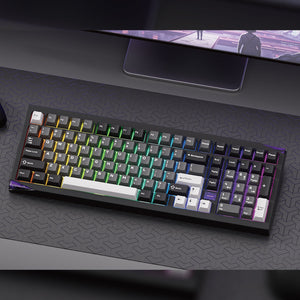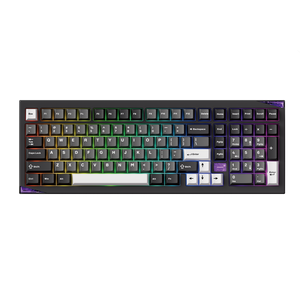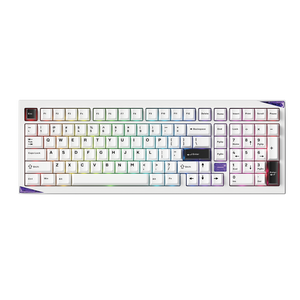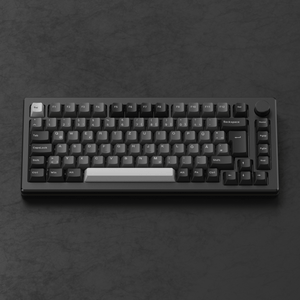Mechanical keyboards are the preferred input method for modern computer users and gamers. They enjoy great popularity due to their unique typing feel, durability, and customization options. But have you ever wondered how long your mechanical keyboard can last? In this article, we'll take a closer look at the key factors that affect the lifespan of a mechanical keyboard and offer practical tips for extending its lifespan. Let's dive in.
How long do mechanical keyboards last?
Average lifespan
The theoretical lifespan of a mechanical keyboard depends primarily on the switches used. However, usage habits vary considerably from person to person, and frequency of use also varies considerably. Human influences and environmental factors also play a role, making an exact prediction difficult—but not impossible.
The theoretical lifespan of a membrane keyboard is currently approximately 8 to 30 million keystrokes . In comparison, a mechanical switch can reach up to 50 or even 100 million keystrokes .
To get an idea of the actual lifespan:
If you type 60 words per minute , a key is pressed approximately 30 times per minute . If you use your keyboard for 10 hours a day, you can expect up to 18,000 keystrokes per day . Based on this calculation, a mechanical keyboard has an average lifespan of 10 to 20 years .
Comparison of keyboard types and their lifespan
| Keyboard type | life | Switch lifetime | Main features | Best use for |
| Mechanical keyboard | 10–20 years | 50–100 million characters | Durable switches, stable typing feel; replaceable keycaps and switches, easy to maintain. | Gaming, programming, frequent typist |
| Membrane keyboard | 1–3 years | 5 million attacks | Soft typing feel, short lifespan; integrated design, difficult to repair or replace parts. | Office work, casual use |
However, not all mechanical keyboards have the same lifespan. The actual lifespan depends on individual usage habits, the environment, and the quality of the keyboard itself.

Factors that influence the lifespan of a mechanical keyboard
1. Quality of the switch
Cheap or low-quality switches can lead to keystroke errors and a poor typing feel, shortening the overall lifespan of the keyboard. High-quality switches, on the other hand, last longer and offer a more comfortable typing experience. These switches are precisely engineered and manufactured to withstand millions of keystrokes without failing.

2. Usage habits
Pressing the keys gently and with moderate pressure will reduce wear and extend the lifespan of the keys. It can also help to avoid using the keyboard continuously for long periods, as short breaks prevent overheating and improve durability.
Typing too hard or using certain keys frequently (like the spacebar or enter key) can accelerate the wear and tear of these keys and shorten their lifespan.
Influence of usage habits on service life
| Usage habits | Estimated lifespan | Explanation |
| Light use (1–2 hours/day) | 15–20 years | Minimal wear on the switch and components, regular cleaning ensures longevity. |
| Moderate use (3–5 hours/day) | 10–15 years | Slight wear on the keycaps and switches, proper care can extend the lifespan. |
| Intensive use (6–8 hours/day) | 8–10 years | Constant use accelerates wear on switches, stabilizers, and keycaps. Maintenance becomes crucial. |
| Aggressive typing/gaming | 5–8 years |
Hard keystrokes and bottoming out shorten the lifespan of the switches; lubricated switches recommended. |
| Regular maintenance | +5 years (beyond normal) | Regular cleaning, lubrication and replacement of worn parts significantly extend the service life. |
| Neglect (no care) | 5–7 years | Dirt buildup and lack of maintenance lead to faster wear of the switches, stabilizers and keycaps. |
3. Environmental factors
The environment in which the keyboard is used can significantly affect its lifespan.
In general, a dry and clean environment helps prevent the accumulation of dust and dirt. This reduces the risk of keystroke errors and extends the lifespan of the keyboard.
On the other hand , harsh conditions such as high humidity, dust, or extreme temperatures can accelerate the aging and wear of keyboard components. This can lead to a shortened lifespan, as moisture causes corrosion and dirt can impair the switch mechanism.
4. Maintenance
Regularly cleaning the keyboard surface of dust and dirt, as well as using compressed air to remove deposits from under the keys, will help keep the keyboard in good condition and extend its lifespan.
If the keyboard isn't cleaned or maintained for an extended period, dust and dirt can accumulate. This increases the risk of keystroke errors and can lead to long-term malfunctions.
5. Keyboard material
Keyboards made of high-quality materials generally have a longer lifespan.
Keycap material: ABS, PBT, and POM are common materials with different properties. PBT and POM are particularly popular due to their abrasion resistance and stability.
Case material:
- Plastic housings are lightweight and inexpensive, but more susceptible to environmental influences.
-
Metal housings offer greater structural stability and durability.
The quality of other components, such as springs and lubricants , also influences the durability and lifespan of the keyboard.
Therefore, when purchasing a mechanical keyboard, you should pay attention to the quality of these materials to ensure a longer lifespan and a better user experience.
6. Other factors
Unforeseen situations can significantly shorten the lifespan of a keyboard:
-
Spills: If water or other liquids get into the keyboard, it can cause short circuits and permanent damage.
-
Falls or strong force: Dropping the keyboard or placing heavy objects on it can cause mechanical damage to the switch or the case.
-
Power fluctuations: An unstable power supply or electrical defects can cause the keyboard to stop working properly or become permanently damaged.
To minimize such risks, the keyboard should be handled with care, protected from liquids, and connected to a stable power source .

How to extend the lifespan of a mechanical keyboard
1. Regular cleaning and maintenance
It's recommended to regularly remove dust and dirt from your keyboard. You can use a can of compressed air to gently blow dust from the keys or a soft brush to clean the keyboard surface.
For stubborn stains, you can use a small amount of alcohol and a cotton swab to gently wipe the keycaps. Be careful not to get any liquid inside the keyboard.
2. Proper handling
-
Avoid excessive force : Although mechanical keyboards are designed to withstand repeated keystrokes, excessive pressure accelerates wear on the mechanical components. Also, avoid repeatedly pressing the same key for extended periods, especially when gaming or programming. Instead, use key combinations or other methods to distribute pressure evenly.
-
Avoid eating and drinking near the keyboard : To avoid accidental spills or attracting pests, never eat or drink while using the keyboard.
-
Avoid extreme temperatures and humidity : Avoid using your keyboard in extreme temperatures or humidity . High temperatures can deform plastic parts, while high humidity can corrode the circuit board.
3. Lubrication of the switch and stabilizers
If you notice that some keys are no longer as smooth, it's time to lubricate the switches .
Lubricating the switches reduces friction and wear , which can extend their lifespan. The stabilizers , especially those on larger switches, also benefit from regular lubrication to ensure smoother operation .
4. Upgrade components if necessary
It is recommended to choose a hot-swappable mechanical keyboard , as this allows you to easily change the keycaps .
For frequently used keys (like the spacebar or enter key), you can purchase replacement keycaps or switches to keep the keyboard in optimal condition.
5. Protection
When the keyboard is not in use, you can cover it with a dust cover or store it in a sealed bag to reduce dust accumulation.
For keyboards that are frequently transported, it is advisable to use a special keyboard bag or case to protect them from bumps and scratches.
When should you consider replacing your mechanical keyboard?
1. Keys do not respond or respond slowly
If you notice that certain keys are no longer responding or require more pressure to trigger, this could indicate damage or wear in the internal mechanism.
Individual key problems can sometimes be resolved by replacing the switch. However, if multiple keys have the same issue, it could indicate that the entire keyboard has reached the end of its life.
If the keyboard is still under warranty, contact the brand for repair. Otherwise, it might be time to buy a new keyboard.
2. The typing experience has changed significantly
Over time and with increasing use, the typing feel of the keyboard may change.
If you feel like the keys have become stiff, loose , or are making unusual noises , this could indicate wear or a lack of lubrication due to long-term use.
In this case, you can try to improve the typing experience by cleaning and re-lubricating the keyboard . If that doesn't work, it might be time to replace the keyboard.
3. Heavy wear
Long-term use can cause the keyboard surface to become worn , scratched , or faded . While this doesn't affect the keyboard's functionality, it can affect your user experience and aesthetic appeal.
If you have high demands on the appearance of the keyboard or wear and tear affects your mood, replacing the keyboard might be a good choice.
4. Difficulty in cleaning and maintenance
If you find your keyboard difficult to clean or that dust and dirt are stuck under the keys, it could be due to poor design or lack of maintenance over time.
In this case, replacing your keyboard with a model that is easier to clean and maintain might be a better option.
5. Personal needs have changed
As technology advances, new keyboard technologies and features continue to emerge. If your keyboard doesn't offer modern features (like lighting, macro programming, multimedia controls , etc.) or you feel its performance no longer meets your needs, upgrading to a newer keyboard might be a wise decision.
Sometimes our needs change with time and experience. Perhaps you're transitioning from a gaming enthusiast to a professional writer and need a keyboard better suited for typing, or you're transitioning from an office worker to a freelancer and need a more portable keyboard. In this case, it's important to choose a keyboard that meets your changing personal needs.
Component replacement vs. complete replacement
It is often the best choice to replace individual components such as switches , keycaps or stabilizers to get a better typing experience.
If the keyboard is no longer in good condition after replacing the components, it might be time to buy a new keyboard.
Conclusion
Mechanical keyboards are built to last and often offer years—or even decades—of reliable performance. With proper care and maintenance, you can significantly extend the lifespan of your keyboard. Regular cleaning, gentle handling, and component replacement can make a big difference and ensure your mechanical keyboard remains a loyal companion for years to come.


